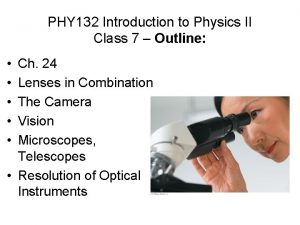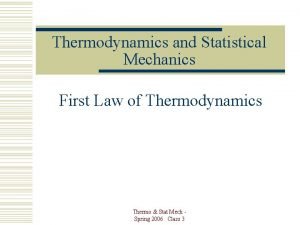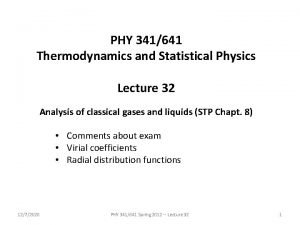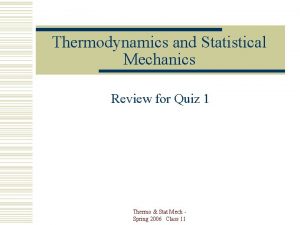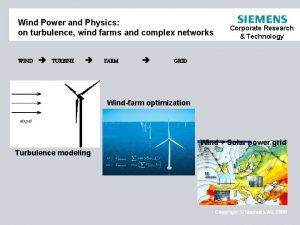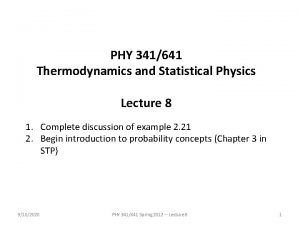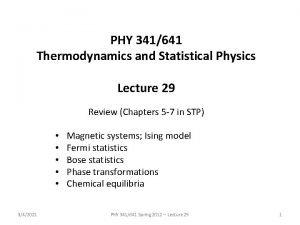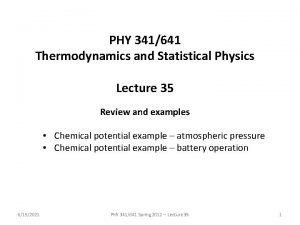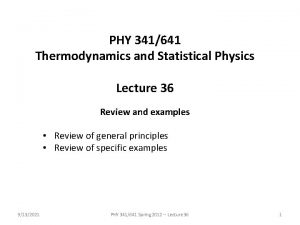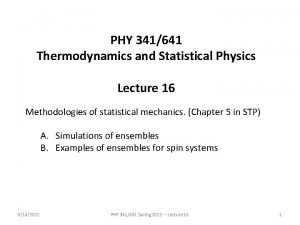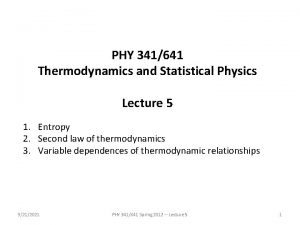PHY 341641 Thermodynamics and Statistical Physics Lecture 10












- Slides: 12

PHY 341/641 Thermodynamics and Statistical Physics Lecture 10 Probability concepts (Chapter 3 in STP) A. Binomial distribution (continued) B. Central Limit theorem C. Poisson distribution and others 10/19/2021 PHY 341/641 Spring 2012 -- Lecture 10 1

Comment on HW problem: 10/19/2021 PHY 341/641 Spring 2012 -- Lecture 10 2

Binomial distribution (review) – Assume each elemental event has 2 possible outcomes (for example H with probability p and T with probability q=1 -p). PN(n) gives the probability distribution for N elemental events having n instances of H. 10/19/2021 PHY 341/641 Spring 2012 -- Lecture 10 3

10/19/2021 PHY 341/641 Spring 2012 -- Lecture 10 4

More general importance of Gaussian probability distribution – “central limit theorem” One-dimensional random walk • It is possible to describe a version of a random walk process as a binomial distribution. If each step has a fixed length s, then an elementary event is a step to the right with probability p or a step to the left with probability q. The probability of n steps to the right is then the binomial distribution. 10/19/2021 PHY 341/641 Spring 2012 -- Lecture 10 5

Example of random walk: stp_Random. Walk 2 D. jar 10/19/2021 PHY 341/641 Spring 2012 -- Lecture 10 6

One-dimensional fixed step walk, continued For N total steps and n steps to the right with probability PN(n), displacement is x=ns-(N-n)s=(2 n-N)s <x>=(2<n>-N)s=(2 p-1)Ns <x 2>-<x>2 =4 pq. Ns 2 Generalization – one-dimensional variable step (si) walk (derivations following Fundamentals of statistical and thermal physics by F. Reif (1965)) 10/19/2021 PHY 341/641 Spring 2012 -- Lecture 10 7

10/19/2021 PHY 341/641 Spring 2012 -- Lecture 10 8

10/19/2021 PHY 341/641 Spring 2012 -- Lecture 10 9

10/19/2021 PHY 341/641 Spring 2012 -- Lecture 10 10

Poisson probability distribution – Approximation to binomial distribution for small p 10/19/2021 PHY 341/641 Spring 2012 -- Lecture 10 11

Other probability distributions: 10/19/2021 PHY 341/641 Spring 2012 -- Lecture 10 12
 Phy 132 lecture 10: ch30
Phy 132 lecture 10: ch30 Thermodynamics and statistical mechanics
Thermodynamics and statistical mechanics Thermodynamics and statistical mechanics
Thermodynamics and statistical mechanics Statistical thermodynamics is a study of
Statistical thermodynamics is a study of Statistical thermodynamics
Statistical thermodynamics 01:640:244 lecture notes - lecture 15: plat, idah, farad
01:640:244 lecture notes - lecture 15: plat, idah, farad Phy 113 past questions and answers
Phy 113 past questions and answers Statistical physics quiz
Statistical physics quiz Statistical physics
Statistical physics Phy 131 past papers
Phy 131 past papers Pa msu
Pa msu The great orthogonality theorem
The great orthogonality theorem Rotational statics
Rotational statics
